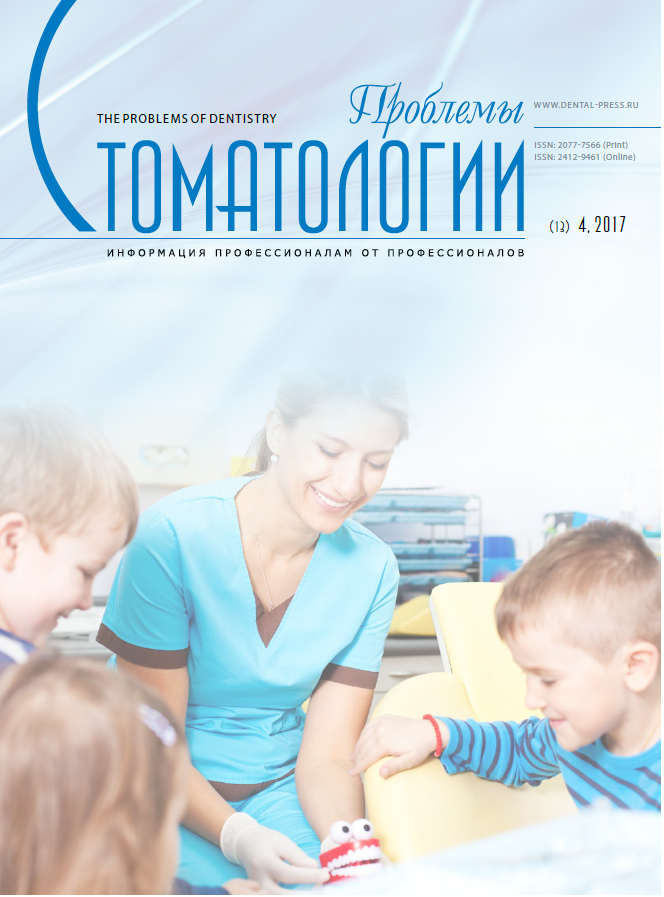Russian Federation
Russian Federation
Russian Federation
In work, on the basis of the analysis of primary medical documentation and the analysis of 8180 addresses of the military personnel at the call of and to the contract at the age of 18 – 55 years in stomatologic offices of military units and a dental out-patient department, and also 4498 case histories of unit of maxillofacial surgery and an odontology of the military-medical organization the frequency and structure of diseases of wisdom teeth at planned or urgent appealability is studied. It is established that diseases of wisdom teeth and pathology of their eruption are one of the main reasons for appealability of the military personnel to the dentist as in an army link (2,5-8,5% of cases), and in a dental out-patient department (4,4-5,25% of cases). In the conditions of unit of maxillofacial surgery and an odontology of a versatile hospital at the military personnel diseases of wisdom teeth make from 2,2% and 5,3%, at the same time at them pathology of the lower wisdom teeth meets more often (from 17,6% to 16,2% of cases), at the same time the vast majority of the servicemen are hospitalized according to urgent indications in connection with pathology of a teething of wisdom or an exacerbation chronic periapical or the parodontal of the centers of a dontogenous infection.
wisdom teeth, the military personnel at the call of, contract servicemen, tooth caries, a pulpitis, a periodontitis, a periodontal disease, a dystopia, a retention, a pericoronitis, a parodontosis, an alveolitis, the military-medical organizations.
1. Grebnev, G. A. Perikoronit / G. A. Grebnev // Voennaya stomatologiya : uchebnik / pod red. G. I. Prohvatilova. - Sankt-Peterburg : VMedA ; ELBI-SPb, 2008. - S. 139-141.
2. Iordanishvili, A. K. Hirurgicheskoe lechenie periodontitov i kist chelyustey / A. K. Iordanishvili. - Sankt-Peterburg : Nordmedizdat, 2000. - 217 s.
3. Kostur, B. K. Funkcional'nye osobennosti zhevatel'nogo apparata u detey / B. K. Kostur. - Leningrad : Medicina, 1972. - 200 s.
4. Luk'yanenko, V. I. O roli ortodonticheskih metodov v kompleksnom lechenii zatrudnennogo prorezyvaniya zubov mudrosti metod. rekomendacii / V. I. Luk'yanenko, B. K. Kostur. - Leningrad : GUZL - 1 LMI im. akad. I.P. Pavlova, 1975. - 9 s.
5. Rudenko, A. T. Perikoronarit / A. T. Rudenko // Voennaya stomatologiya : uchebnik. - Leningrad, 1987. - S. 108-113.
6. Bui C.H., Seldin E.B., Dodson T.B. Types, frequencies, and risk factors for complications after third molar extraction. J. Oral Maxillofac. Surg, 2003, vol. 61, pp. 1379-1389. doi:https://doi.org/10.1016/j.joms.2003.04.001.
7. Laureano J.R., Maurette M., Filho P.E., Allais M., Cotinho C.F. Clinical comparative study of the effectiveness of two dosages of Dexamethasone to control postoperative swelling, trismus and pain after the surgical extraction of mandibular impacted third molars. Med. Oral Patol. Oral Cir. Bucal, 2008, vol. 13(2), pp. 129-132.
8. Ogundipe O.K., Ugboko V.I., Owotade F.J. Can autologous platelet-rich plasma gel enhance healing after surgical extraction of mandibular third molars. J. Oral Maxillofac. Surg, 2011, vol. 69, pp. 2305-2310. doi:https://doi.org/10.1016/j.joms.2011.02.014.
9. Uyanık L.O., Bilginaylar K., Etikan İ. Effects of platelet-rich fibrin and piezosurgery on impacted mandibular third molar surgery outcomes. Head Face Med, 2015, vol. 11, pp. 25-32. doi:https://doi.org/10.1186/s13005-015-0081-x.
10. Romeo U., Libotte F., Palaia G., Tenore G. Is Er : YAG laser vs conventional rotary osteotomy better in the post operative period for lower third molar surgery? Randomized split mouth clinical study. Oral Maxillofac. Surg, 2015, vol. 73(2), pp. 211-218. doi:https://doi.org/10.1016/j.joms.2014.08.013.



















